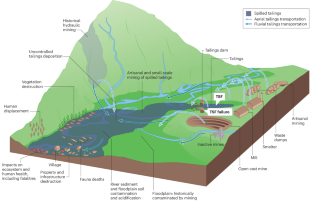Tailings storage facilities, failures and disaster risk
引用次数: 0
Abstract
Mining generates 13 billion tonnes per year of potentially toxic wet slurry waste, called tailings, commonly deposited in tailings storage facilities (TSF). Since 1915, 257 TSF failures have occurred, releasing a total of ~250 million m3 of tailings, destroying areas up to ~5,000 km2, killing an estimated 2,650 people and impacting ~317,000 people through displacement, property damage, and risks to livelihoods and health. In this Review, we provide an interdisciplinary approach to understanding the causes, effects and response to TSF failures, applying a disaster risk reduction framework. TSF failures can occur owing to earthquakes, overtopping, weak foundations and liquefaction, among other mechanisms. The severities and volumes of TSF failures have increased since the year 2000, owing to increasing mine waste generation from the exploitation of larger, lower-grade deposits. Despite the increasingly severe impacts, the mining industry has been hesitant to use the term ‘disaster’ to analyse TSF failure, presumably to avoid liability. TSF failures should be considered as disasters when they cause severe disruption to the functioning of ecological and social systems. Future research should build on attempts to link tailings facility locations to situated risk factors by improving spatial and time series analysis, reducing reliance on corporate disclosures, and increasing the visibility of priority locations and patterns of concern. Mine tailings are voluminous and often toxic wastes, whose management is a global safety and sustainability challenge. This Review summarizes the major tailings storage facility disasters and impacts, emphasizing the urgent need for risk reduction approaches for management and policy.


尾矿储存设施、故障和灾害风险
采矿业每年产生 130 亿吨可能有毒的湿泥浆废物,称为尾矿,通常堆放在尾矿库 (TSF)。自 1915 年以来,共发生了 257 起尾矿库溃坝事故,释放出总计约 2.5 亿立方米的尾矿,毁坏面积达约 5,000 平方公里,造成约 2,650 人死亡,约 31.7 万人流离失所、财产损失以及生计和健康风险。在本《综述》中,我们采用跨学科方法,在减少灾害风险的框架下,了解台风暴发的原因、影响和应对措施。除其他机制外,地震、倾覆、地基薄弱和液化都可能导致临时安全设施失效。自 2000 年以来,由于开采规模较大、品位较低的矿藏所产生的矿山废料越来越多,导致临时采空区坍塌的严重程度和数量不断增加。尽管影响越来越严重,但采矿业一直不愿使用 "灾难 "一词来分析 TSF 故障,可能是为了避免承担责任。当 TSF 故障对生态和社会系统的运行造成严重破坏时,就应将其视为灾难。未来的研究应通过改进空间和时间序列分析、减少对企业披露信息的依赖以及提高重点关注地点和模式的可见度,在尝试将尾矿设施位置与所处风险因素联系起来的基础上更进一步。
本文章由计算机程序翻译,如有差异,请以英文原文为准。
求助全文
约1分钟内获得全文
求助全文

 求助内容:
求助内容: 应助结果提醒方式:
应助结果提醒方式:


